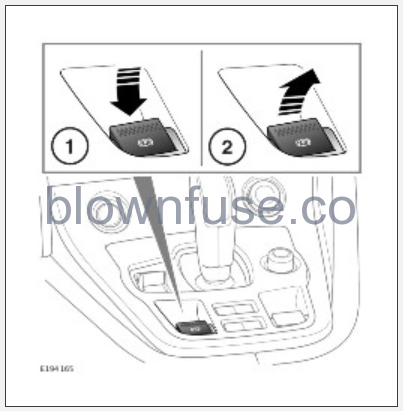
2022 Jaguar F-TYPE Speed Limiter
 BRAKE SYSTEMS SAFETY
BRAKE SYSTEMS SAFETY
Make sure the following warnings have been read and fully understood. Failure to follow the guidance given could affect vehicle safety, leading to serious injury or death.
If the red brake warning lamp illuminates, safely bring the vehicle to a stop, as quickly as possible, and seek qualified assistance.
If the amber brake warning lamp illuminates, drive with care, avoiding heavy brake pedal application, and seek qualified assistance. Failure to do so can result in serious injury or death.
Do not rest a foot on the brake pedal while the vehicle is in motion. Doing so can damage the braking system and reduce braking efficiency.
Do not drive if the message Brake fluid low is displayed. Check the brake fluid level and top up, as necessary. If necessary, seek qualified assistance before continuing.
Never allow the vehicle to coast (freewheel) with the engine switched off. The engine must be running to provide full braking assistance. The brakes still function with the engine switched off, but far more brake pedal pressure is required to operate them.
Never place non-approved floor matting or any other obstructions under the brake pedal. This restricts pedal travel and braking efficiency.
Driving through heavy rain or water can have an adverse effect on braking efficiency, which may result in an accident. Under such circumstances, it is recommended to lightly apply the brakes intermittently, in order to dry the brakes.
Do not tap the brake pedal repeatedly in quick succession at any time. Doing so interrupts operation of the braking system and may increase stopping distances. Make sure to read and follow the important information and instructions contained in the warnings listed. See BRAKE (RED) and BRAKE (AMBER).
Do not drive if the message Brakes overheating is displayed. Stop the vehicle as soon as safety permits, and allow the brakes to cool. If necessary, seek qualified assistance before continuing.
The Brakes overheating message is only available on vehicles with carbon ceramic brakes.
Operating noise levels of carbon ceramic brake discs can be higher than those associated with iron brake discs.
STEEP SLOPES
If the vehicle is stationary on a steep, slippery slope, it may begin to slide, even with the brakes applied. Without wheel rotation, the Anti-lock Braking System (ABS) cannot determine vehicle movement. To counteract this, briefly release the brake pedal, allowing wheel rotation. Re-apply the brake pedal to allow the ABS to gain control.
The vehicle needs to be in Neutral (N) or an appropriate gear to descend the slope. The Electric Parking Brake (EPB) must not be applied.
EMERGENCY BRAKE ASSIST (EBA)
If the brakes are rapidly applied, the Emergency Brake Assist (EBA) system automatically boosts the braking force to its maximum. The result is that the EBA system helps to bring the vehicle to a stop as quickly as possible.
The EBA system stops operating as soon as the brake pedal is released.
The amber brake warning lamp indicates an EBA system fault and the instrument panel displays a warning message. In this event, drive with care, avoiding heavy brake pedal application. Seek qualified assistance. See BRAKE (AMBER).
ELECTRONIC BRAKE-FORCE DISTRIBUTION (EBD)
The Electronic Brake-force Distribution (EBD) system controls the balance of braking forces supplied to the front and rear wheels. The result is that the EBD system helps to maintain maximum braking efficiency and stability.
If the vehicle has a light load, e.g., driver only and no luggage, the EBD system reduces the braking force applied to the rear wheels. If the vehicle is heavily laden, e.g., passengers and luggage, the EBD system increases the braking force to the rear wheels.
The red brake warning lamp indicates an EBD system fault and the instrument panel displays a warning message. In this event, gently and safely stop the vehicle. Seek qualified assistance. See BRAKE (RED).
ELECTRIC PARKING BRAKE (EPB)
Do not rely on the Electric Parking Brake (EPB) to hold the vehicle stationary if the brake warning lamp is illuminated or the EPB warning lamp is flashing. Seek qualified assistance urgently. A faulty EPB system can lead to personal injury or death.
The Electric Parking Brake (EPB) operates on the rear wheels, therefore, secure parking of the vehicle is dependent on being on a hard and stable surface. Operating the EPB on wet or loose surfaces may lead to personal injury or death.
Do not rely on the EPB to operate effectively, if the rear wheels have been immersed in mud or water. Doing so may result in serious personal injury or death.
Driving the vehicle with the EPB applied causes serious damage to the braking system.

- With the ignition switched on, press the brake pedal and press down on the EPB switch to release the EPB.
- Pull the EPB switch up and release it to apply the EPB. The EPB warning lamp illuminates to confirm. See ELECTRIC PARKING BRAKE (EPB) (RED).
NOTES
The red EPB warning lamp continues to illuminate for at least 10 seconds after the ignition has been switched off.
The EPB automatically applies when Park (P) is selected.
To prevent this automatic operation, when the vehicle is stationary, press and hold the EPB switch in the release position before selecting P.
The EPB applies automatically if the ignition is switched off and the vehicle’s speed is below 2 mph (3 km/h).
To prevent this automatic operation, when the vehicle is stationary, press and hold the EPB switch in the release position. Within 5 seconds, switch off the ignition and continue to hold the EPB switch for a further 2 seconds.
If the EPB is operated when the vehicle’s speed is less than 2 mph (3 km/h), the vehicle is brought to an abrupt stop. The stop lights do not illuminate.
Driving the vehicle with the EPB applied causes serious damage to the braking system.
If the vehicle is stationary with the EPB applied and the transmission engaged in a forward or reverse gear, press the accelerator pedal to gradually release the EPB. The result is that the vehicle can be driven away smoothly.
When shifting from P with the EPB applied, the EPB automatically releases to allow a smooth drive away.
Automatic EPB release is only possible when the driver’s door is closed or the driver’s seat belt is buckled.
To override the EPB automatic release, pull the EPB switch up and hold.
In an emergency, the EPB may be used to bring the vehicle to a complete stop by ensuring a controlled reduction in the speed. With the vehicle traveling at more than 2 mph (3 km/h), pull and hold the EPB switch wile releasing the brake pedal. The EPB warning lamp flashes, a warning chime sounds, and the instrument panel displays a warning message. The stop lights illuminate. Releasing the EPB switch, or pressing the accelerator pedal, releases the EPB.
If the system detects a fault with the EPB, the amber brake warning lamp illuminates and the instrument panel displays a warning message.
If the system detects a fault while the EPB is operating, the red EPB warning lamp flashes and the instrument panel displays a warning message.
HILL START ASSIST
Hill start assist activates when the vehicle is pulling away from a standstill to ascend a hill. When the brake pedal is released, hill start assist smoothly releases the brake pressure, allowing the vehicle to pull away without rolling backward.
Hill start assist system is part of the Dynamic Stability Control (DSC) system.
If a hill start assist fault is detected, the DSC OFF warning lamp illuminates. The instrument panel also displays the warning message Stability Control Not Available – Drive With Care. See DYNAMIC STABILITY CONTROL (DSC) OFF (AMBER).
